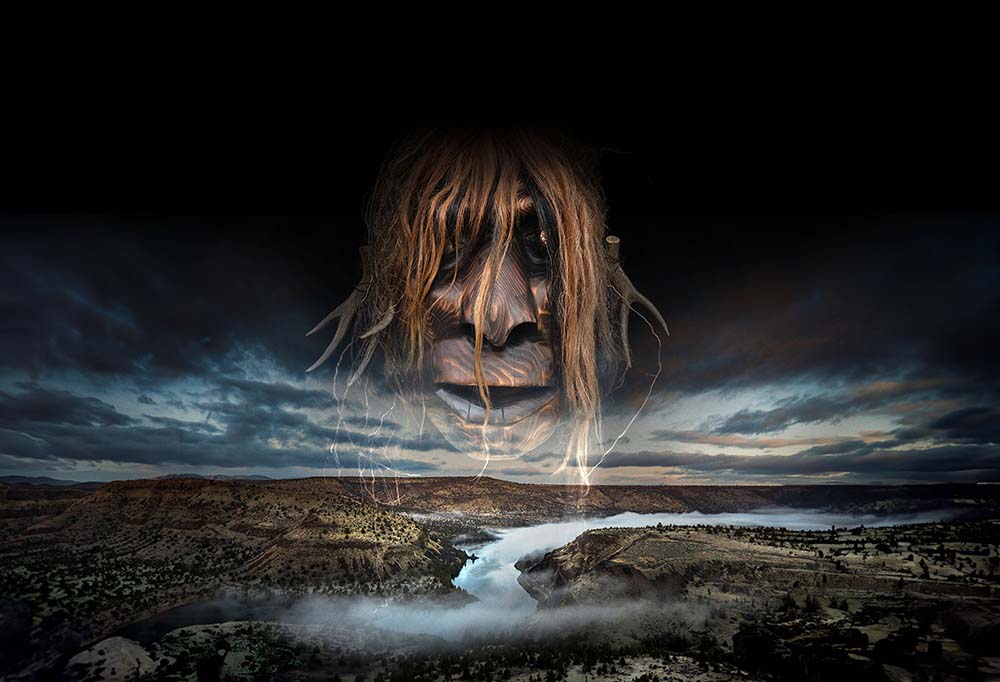
- Details
- By High Desert Museum
Sasquatch’s Past, Present and Future in the High Desert Region Explored in Works by Five Indigenous Artists
What does Sasquatch — also known as Bigfoot — represent to you? The unknown? Adventure? Mystery?
Sensing Sasquatch is a major new exhibition opening March 2 at the High Desert Museum examining the primate-like, reclusive and elusive being in the context of the High Desert region. The exhibit will be on view through January 12, 2025.
Native peoples of the Plateau have long encountered and told stories about Sasquatch. Sensing Sasquatch will explore Sasquatch’s past, present and future in the High Desert region through an Indigenous lens.
Works by five Indigenous artists will share Bigfoot with visitors, including: Phillip Cash Cash, Ph.D. (Nez Perce, Cayuse), HollyAnna CougarTracks DeCoteau Littlebull (Yakama, Nez Perce, Cayuse, Cree), Charlene “Tillie” Moody (Warm Springs), Frank Buffalo Hyde (Nez Perce, Onondaga) and Rocky LaRock (Salish). Rather than the pop culture view of Sasquatch, this exhibition will show is centered on Indigenous voices and storytelling about this non-human other in the High Desert.
The original word for Sasquatch is “Sasq’ets,” which comes from the Halq’emeylem language of Coast Salish First Nation peoples from southwestern British Columbia. Sasquatch’s habitat is often associated with the wet rainforests of the coastal Pacific Northwest, but in the High Desert, Sasquatch strides among the dry canyonlands, ponderosa pine forests and shrublands.
The question of whether Sasquatch exists is irrelevant to the exhibit’s theme since in many Indigenous traditions, Sasquatch is a bona fide living, breathing, sentient being. Indeed, for many tribes across North America, Sasquatch is regarded as an elder, a relative and a spiritual guide who appears to deliver important messages to humans.
A contemporary carved mask by Rocky LaRock will show visitors that knowledge of Sasquatch is both ancient and contemporary. A digital language map will show the various names for Sasquatch across the Indigenous Plateau and beyond.
Sasquatch as a conscious being with the agency to communicate with humans will be shown in direct opposition to the popular view of Sasquatch as shy and who runs and hides when humans approach. Phillip Cash Cash’s commissioned 13-foot-tall “Bigfoot Rattle,” made of cottonwood, that Sasquatch would use.
Some Indigenous peoples have sought to protect Sasquatch’s anonymity and prevent human access to its wilderness habitat. HollyAnna CougarTracks DeCoteau Littlebull’s commissioned “Protector” sculpture — will depict Sasquatch as a protective “big sister” — not a predator but one who deserves respect and safeguarding.
Frank Buffalo Hyde’s (Nez Perce, Onondaga) commissioned large-scale futuristic Sasquatch painting with 3-D relief elements will illustrate the perception of Sasquatch as an interdimensional enigma who lurked in the forest for millennia to a modern being that continues to live among humans in the present.
Before entering the exhibition there will be an homage to pervasive Sasquatch notions, but visitors will be asked to leave these ideas and perceptions behind to consider another side of Sasquatch’s story. Outside the exhibition, a “bring-your-own” sticker interactive will encourage visitors to reflect on the popularity and kitsch of mainstream Sasquatch representations. Visitors will place their stickers on the back of a car that’s driving away into the distance — symbolically transporting away their Sasquatch stereotypes and entering a new realm of experience and insight.
Learn more at highdesertmuseum.org/sensing-sasquatch.
 From left, Phillip Cash Cash, Ph.D., (Nez Perce, Cayuse); artist Frank Buffalo Hyde’s study for his exhibition piece; a mask by Rocky LaRock (Salish); HollyAnna CougarTracks (Yakama, Nez Perce, Cayuse, Cree); Frank Buffalo Hyde (Nez Perce, Onondaga).
From left, Phillip Cash Cash, Ph.D., (Nez Perce, Cayuse); artist Frank Buffalo Hyde’s study for his exhibition piece; a mask by Rocky LaRock (Salish); HollyAnna CougarTracks (Yakama, Nez Perce, Cayuse, Cree); Frank Buffalo Hyde (Nez Perce, Onondaga).
These stories must be heard.
This May, we are highlighting our coverage of Indian boarding schools and their generational impact on Native families and Native communities. Giving survivors of boarding schools and their descendants the opportunity to share their stories is an important step toward healing — not just because they are speaking, but because they are being heard. Their stories must be heard. Help our efforts to make sure Native stories and Native voices are heard in 2024. Please consider a recurring donation to help fund our ongoing coverage of Indian boarding schools. Donate to Native News Online today and support independent Indigenous-centered journalism. Thank you.
